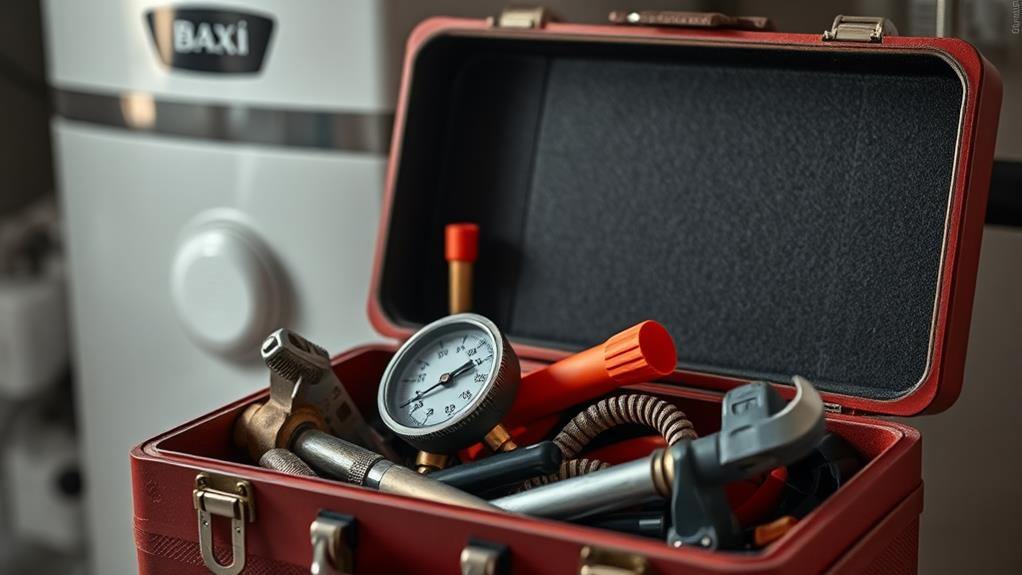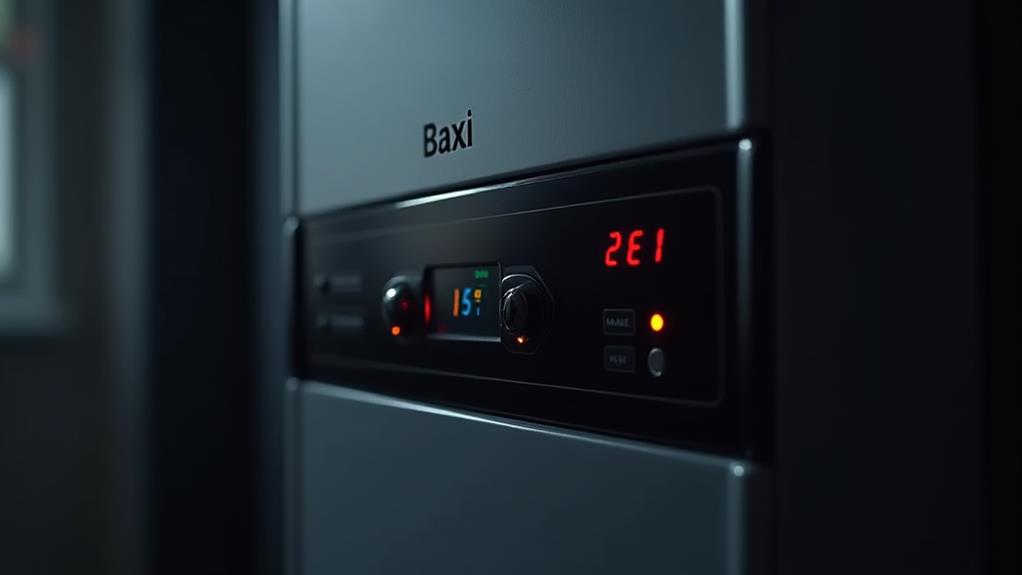When you see the E1 error code on your Baxi boiler, it’s signaling low water pressure, usually below 1 bar. This is a built-in safety measure to prevent damage. Check the pressure gauge on the front panel; it should read between 1.0 and 2.0 bars. Causes include leaks, valve issues, or air in radiators. To fix this, locate the filling loop, open the valves to increase pressure, and then secure them. Regular monthly pressure checks can prevent future errors. For more detailed instructions and tools required, consider professional assistance or further information.
Key insights
- The E1 error code signifies low water pressure in Baxi boilers, typically below 1 bar.
- Regularly check the pressure gauge to ensure pressure is between 1.0 to 2.0 bars.
- Common causes include leaks, valve issues, or trapped air in the system.
- To fix, locate the filling loop and adjust valves to restore pressure.
- Persistent issues may require professional inspection to prevent further malfunctions.
Understanding the E1 Error Code

The E1 error code on a Baxi boiler indicates a problem with water pressure. When this error appears, it means the boiler’s pressure has dropped below the required level for optimal boiler functionality. Regular boiler servicing, such as that provided by JAR Mechanical LTD, can help identify minor issues like these before they become major problems. Typically, a Baxi boiler operates efficiently when the pressure gauge reads between 1 and 2 bar.
If the pressure deviates from this range, the boiler’s ability to heat water effectively is compromised, triggering the E1 error. To understand the E1 error, you first need to locate the pressure gauge on your boiler. It’s usually found on the front panel, displaying the current pressure. When the pressure falls below 1 bar, the E1 error is activated as a safety measure to prevent potential damage to the boiler, emphasizing the importance of regular servicing to maintain operational efficiency.
This error disables the boiler’s heating function, guaranteeing that no further harm occurs due to inadequate water pressure. Monitoring boiler functionality involves checking the pressure gauge regularly to prevent such errors. If you notice the E1 error, it’s essential to address it promptly. By maintaining appropriate water pressure, you make sure the boiler operates efficiently, prolonging its lifespan and maximizing energy efficiency. A consistent pressure level assures the boiler remains reliable, providing consistent heating and hot water.
Causes of Low Boiler Pressure
Understanding the common causes of pressure loss in your Baxi boiler is essential, as these issues can trigger the E1 error code. Regular maintenance and checks by Gas Safe registered engineers are important to guarantee the system’s efficiency and performance. Symptoms such as a noticeable drop in heating performance or unusual noises often indicate a pressure issue. Regularly checking your system for leaks or bleeding radiators can help you identify and resolve these problems before they escalate.
Common Pressure Loss Causes
Understanding the common causes of pressure loss in a Baxi boiler is essential for maintaining peak performance and preventing the E1 error code from appearing. Low boiler pressure can lead to inefficient heating and potential system shutdowns. Tackling pressure loss involves identifying the root causes, which are often linked to specific mechanical issues.
- Leak Detection: Leaks in the system are a primary reason for pressure loss. Regularly inspect all visible pipes, joints, and connectors. Use a pressure gauge to monitor changes over time. If you notice any dampness or water pooling, you might need to repair or replace damaged sections.
- Valve Issues: Faulty valves, such as the pressure relief valve, can result in pressure drops. Confirm that all valves are functioning correctly and are tightly closed. If a valve is leaking, it may require resealing or replacement.
- Radiator Bleeding: Air trapped in radiators can cause pressure to drop. Bleeding radiators may release this air, restoring normal pressure levels.
- Component Wear: Over time, components like the expansion vessel or pump may wear out, leading to pressure issues. Regular maintenance checks and timely replacement of worn parts can help maintain ideal pressure.
Addressing these issues proactively can save you from unexpected boiler malfunctions.
Identifying Pressure Drop Symptoms
Spotting pressure drop symptoms in your Baxi boiler is crucial for diagnosing low boiler pressure issues before they escalate. One of the first pressure symptoms you might notice is a sudden decrease in heating efficiency. If your radiators aren’t warming up as quickly or evenly as before, this could be a sign of low pressure. Keep an eye on the boiler indicators, specifically the pressure gauge. A reading below 1 bar usually signifies a pressure drop that needs attention.
Another symptom to watch for is frequent boiler shutdowns. When the pressure is too low, your Baxi boiler may activate safety features, causing it to shut down intermittently to prevent damage. You might also hear unusual noises, like gurgling or banging, which can indicate trapped air due to low pressure.
Moreover, inspect for any visible leaks around your boiler or associated pipework. Leaks are common culprits for pressure loss and can exacerbate the issue if not promptly addressed. By regularly monitoring these boiler indicators and pressure symptoms, you can maintain peak boiler function and prevent the inconvenience of unexpected breakdowns. Taking quick action will guarantee your heating system operates efficiently and safely.
How to Check Boiler Pressure

To properly assess your Baxi boiler’s pressure, which is a key aspect of routine checks to enhance longevity and efficiency, first locate the pressure gauge. This gauge is typically found on the front panel of the boiler. Verify the needle falls within the recommended 1.0 to 2.0 bar range. If not, you’ll need to adjust the pressure levels by using the filling loop. This is part of maintaining the boiler’s high efficiency, a trait Baxi Commercial is known for. Always turn off the boiler and allow it to cool before making any adjustments to avoid potential hazards.
Locate Pressure Gauge
Precision in maintaining your Baxi boiler begins with knowing how to check its pressure, an essential step in guaranteeing its proper functioning. The pressure gauge location is typically found on the front panel of your boiler, often near the control panel or beneath a protective cover. Identifying this component is vital, as it provides real-time data on the boiler’s internal pressure.
To accurately interpret the gauge reading, follow these steps:
- Locate the Gauge: Look for a small, round dial with numbers and a needle pointing to the current pressure level. It’s typically marked in bars, the unit of pressure measurement.
- Understand the Range: For most Baxi boilers, the ideal pressure range is between 1.0 and 2.0 bars. Read the manual for your specific model to confirm these values.
- Check for Anomalies: If the reading falls below or exceeds the recommended range, your boiler might not function efficiently, potentially leading to an E1 error code.
- Regular Monitoring: Make a habit of checking the pressure gauge regularly to guarantee the boiler operates within safe parameters, preventing issues before they arise.
Adjust Pressure Levels
When your Baxi boiler’s pressure isn’t within the ideal range, adjusting it is vital to confirm efficient operation and to avoid the E1 error code. Begin by identifying the current pressure level using the pressure gauge, typically located on the front or underside of the boiler. The gauge should read between 1.0 and 1.5 bar, which is the best range for most Baxi models. If the pressure falls below or exceeds this range, immediate action is necessary as part of regular boiler maintenance to guarantee reliable performance.
To increase the pressure, locate the filling loop, which usually comprises two braided hoses with valves. Open these valves slowly and monitor the pressure gauge. Once the gauge reaches the desired range, close the valves carefully to prevent over-pressurization. On the other hand, if the pressure is too high, you might need to bleed a radiator to release excess pressure. Use a radiator key to turn the bleed valve counterclockwise and let some air escape.
Consistent pressure regulation is vital for efficient boiler operation. Regularly check the pressure gauge and adjust as necessary to maintain your Baxi boiler’s best performance, preventing issues like the E1 error code.
Steps to Repressurize Your Boiler
Repressurizing your Baxi boiler is a critical task that guarantees its efficient operation and longevity. Regular boiler maintenance, much like plant room maintenance, guarantees your system runs smoothly and avoids unexpected breakdowns – this includes monitoring for errors or changes in performance. When you notice an E1 error code, it’s often related to pressure regulation issues. Here’s how you can repressurize your boiler effectively:
- Check the Pressure Gauge: Locate the pressure gauge on your boiler’s control panel. The ideal pressure level should be between 1.0 and 1.5 bar. If the reading is below this range, your system needs repressurization.
- Locate the Filling Loop: The filling loop is a silver hose connecting two valves. It’s usually found beneath the boiler. Verify that the valves are closed before proceeding, as this prevents water from entering the system prematurely.
- Open the Valves: Gently turn both valves to allow water from the mains into the system. You’ll hear water flowing, and the pressure gauge will start to rise. Keep an eye on the gauge until it reaches the desired pressure level.
- Close the Valves: Once the correct pressure is achieved, close both valves securely to prevent over-pressurization. Double-check the gauge to confirm stability before restarting the boiler. Following these steps guarantees safe and efficient boiler operation.
Tools Needed for Repressurization

To successfully repressurize your Baxi boiler, gather a few essential tools that will make the task straightforward and efficient. First, you’ll need a filling loop, which is typically a silver, flexible hose. This crucial piece of repressurization tools connects the boiler to the cold water supply, enabling you to safely adjust the pressure. Significantly, similar to how an experienced engineer would assess the heating needs of a commercial building, understanding the correct way to use these tools is imperative for successful repressurization. Make certain the filling loop is securely attached, with the valves properly fitted at both ends.
Next, a pressure gauge is necessary equipment for monitoring the boiler’s pressure levels. Most Baxi boilers have this built-in, but if yours doesn’t, an external gauge will be required. The gauge guarantees you don’t over-pressurize the system, maintaining the ideal pressure range, typically between 1.0 and 1.5 bar.
Additionally, a pair of adjustable wrenches might be needed to tighten or loosen any fittings on the filling loop. This guarantees a secure connection and prevents any leaks during the repressurization process. Finally, a towel or cloth is useful for catching any water drips, keeping the area tidy and free of spills. With these tools at hand, you’re well-prepared to handle the repressurization efficiently.
Preventing E1 Error in Future
In the quest for a consistently efficient Baxi boiler, preventing the E1 error code from recurring is vital. It’s imperative to understand that this involves not only boiler maintenance, but also guaranteeing the safety and efficiency of your gas appliances and systems. You can achieve this by implementing regular boiler maintenance tips and keeping an eye on pressure monitoring systems. Here are some steps you can take:
- Regular Pressure Checks: Make it a habit to check the boiler pressure at least once a month. The ideal range is typically between 1.0 and 1.5 bar. If the pressure falls outside this range, it’s important to adjust it promptly to prevent the E1 error.
- Annual Servicing: Schedule an annual service with a qualified Gas Safe registered engineer to inspect and maintain your Baxi boiler. This thorough check-up helps identify potential issues before they escalate into error codes, making certain that your gas systems are compliant with safety standards.
- Bleed Radiators: Air trapped in the radiators can affect the boiler’s pressure. Bleed your radiators regularly to guarantee peak performance and prevent unnecessary strain on the system.
- Install a Pressure Monitoring System: Consider installing a pressure monitoring system that alerts you to any significant pressure changes. This proactive measure allows you to address issues before they trigger an E1 error, making certain smooth boiler operation.
When to Call a Professional

A hissing sound or a persistent drop in pressure can be a telltale sign that it’s time to call a professional for your Baxi boiler. These issues may indicate underlying problems that require more than basic troubleshooting. Regular boiler maintenance is essential to guarantee your system operates safely and efficiently. If you’ve already attempted simple fixes, like bleeding radiators or checking for visible leaks, and the E1 error persists, engaging professional services is your next step.
Professionals have the expertise to diagnose complex issues, such as faulty pressure relief valves or malfunctioning sensors, which can lead to the E1 error. They possess the necessary tools and experience to perform thorough inspections and repairs, minimizing downtime and preventing further damage. Furthermore, professionals can guarantee that your boiler adheres to safety standards, reducing the risk of hazardous situations like gas leaks.
Don’t attempt to dismantle or repair internal components without proper training, as it could void warranties or exacerbate the issue. Relying on expert boiler maintenance guarantees that your Baxi boiler remains reliable and efficient, avoiding costly future repairs. Prioritizing professional services now can save you from recurring headaches and ultimately extend the life of your boiler.
Common Misconceptions About E1 Error
Despite its prevalence, the E1 error code on a Baxi boiler is often misunderstood, leading to unnecessary anxiety and misguided attempts at resolution. Many assume it’s a catastrophic failure when, in reality, it can be caused by minor issues like faulty sensors or user errors during setup.
- Faulty Sensors: Often, people think the E1 error indicates a severe mechanical problem. However, it could simply mean a sensor is malfunctioning. Inspecting and possibly replacing the sensor could resolve the issue efficiently.
- User Errors: Misconfigurations during initial setup or adjustments can trigger the E1 code. Double-checking settings and ensuring correct input can prevent these errors. Sometimes, even a simple reset can clear the error.
- Immediate Professional Help: While professional intervention is sometimes necessary, you don’t always need to call for help immediately. Checking basic issues like water pressure or ensuring the boiler is powered correctly can save time and cost.
- Permanent Damage Assumption: Many users jump to the realization that the E1 error means permanent damage to the boiler. In most cases, addressing the underlying causes, such as sensor issues or incorrect settings, will restore normal functionality without lasting damage.
Frequently Asked Questions
What Is the Average Cost to Repair a Baxi Boiler With an E1 Error Code?
When you’re facing repair costs for your Baxi boiler, it’s crucial to understand the impact of regular boiler maintenance. On average, repairing a Baxi boiler may cost you between $100 and $300. These costs vary based on labor, parts, and how well you’ve maintained your system. Regular checks can prevent minor issues from escalating. Always consult a certified technician to verify your boiler is running efficiently and safely.
How Does the E1 Error Code Affect Energy Efficiency in Baxi Boilers?
When you encounter an issue affecting energy consumption and boiler efficiency, you might notice your heating system working harder, burning more fuel, and operating less effectively. This problem leads to increased energy consumption and reduced boiler efficiency. Your system struggles to maintain desired temperatures, causing higher utility bills and potential wear on components. Addressing the root cause swiftly restores efficiency, optimizes energy usage, and guarantees your boiler operates at peak performance, saving you money and energy.
Are There Any Warranties That Cover E1 Error Code Repairs for Baxi Boilers?
You’re wondering about warranty types and repair coverage for boiler issues. Typically, manufacturer warranties cover repairs for a set period, usually one to two years. Extended warranties might offer more extensive coverage. It’s essential to check the specifics of your warranty to see if it includes labor and parts for error code repairs. Contacting Baxi or reviewing your warranty documentation will clarify what’s covered, ensuring you’re not paying unnecessary repair costs.
Can I Claim Insurance for Damage Caused by E1 Error Code in Baxi Boilers?
To claim insurance for damage, start by reviewing your policy’s coverage specifics. Insurance claims typically require a thorough damage assessment by a qualified technician. Document all issues related to the malfunction, including any resulting water damage or mechanical failures. Contact your insurer promptly, providing detailed reports and repair invoices. Understanding your policy’s exclusions and conditions will help guarantee a smoother claims process, potentially covering repair expenses from unforeseen damages.
What Are Common Signs That My Baxi Boiler Might Soon Display an E1 Error Code?
If your Baxi boiler’s acting like a broken record, it’s time to check for signs before an E1 error pops up. Keep an eye on fluctuations in water pressure, unusual noises, or inconsistent heating. Regular boiler maintenance is essential. Troubleshooting tips include checking connections, ensuring proper ventilation, and inspecting for leaks. Catching these early can save you from future headaches and keep your boiler in tip-top shape.
Summary
You’ve navigated the labyrinth of the E1 error code with grace, and now your boiler hums contentedly, free from the low-pressure blues. By keeping an eye on those pressure levels and performing regular checks, you’ll avoid future hiccups and guarantee warmth embraces your home. Remember, should things go awry, a friendly professional is just a call away. Don’t be swayed by myths; knowledge is your trusty companion in maintaining a cozy, well-functioning boiler.

